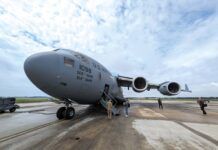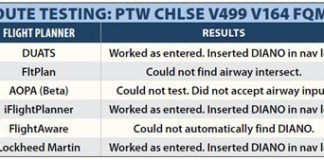Many of us would rather fly an approach to minimums in harsh conditions than depart in the same weather. Perhaps one of the reasons is that we thoroughly brief the approach and have the opportunity to make sure we’re stabilized on the approach. But on a departure, it all seems to happen at once. We’ve got to deal with multiple configuration changes to the airplane while immediately handling some occasionally challenging navigational chores. A thorough briefing is critical.
For our purposes here, we’ll talk about three different types of departure procedures: the standard textual obstacle departure procedure, or ODP, the charted ODP and full-on Standard Instrument Departures, or SIDs.
Respect That ODP
As an instrument student, your first exposure to departure procedures was probably the simple text-based procedure found at the front of the FAA Terminal Procedures or on the back of the Jepp -9 chart. Denver’s Rocky Mountain Metropolitan Airport, KBJC, is a good example. The airport is close to the Front Range of the Rockies, so clearly there are some obstacles to be avoided.
You’re planning your departure for Sacramento, with a general course of 258 degrees. Since your course isn’t in the easy segment where you just climb on course, you’ve must turn to 142, intercept the DEN R-280 and fly it inbound to the VOR and climb in a hold.
You lay this out on the chart and see that with a likely departure from Runway 29R, you’ll probably need to request a southeast departure, which tower is probably expecting. You plan to fly a right traffic pattern until you get cleared on course, presumably from right downwind. You see that you’ll fly that heading until intercepting the DEN R-280 inbound, climbing all the way.
This is usually about as difficult as a text ODP will get. You’ll often have to figure out which segment your on-course heading uses, then comply with the instructions, often flying a heading to intercept a VOR radial and then fly that radial to some holding point until you’ve climbed above the terrain. The hardest part can just be sorting out those instructions, but like most any procedure, if you methodically think it through or chart it if in doubt, it shouldn’t be a problem.
Note that if ATC does not assign a specific departure procedure or instructions, you may fly the ODP without explicitly being cleared for it. Indeed, certificated operators are usually required to fly them in the absence of other departure instructions. Also, the expected minimum climb is 200 feet per NM.
Complex ODP
We’ll leave Colorado and zoom up to Montana for Missoula’s GRZLY TWO charted obstacle departure. Charted ODPs are hybrids that are neither the simple text ODPs nor full charted SIDs. They’re just ODPs that are complex enough to be deemed worthy of a chart in addition to the text.
The mountains all around Missoula require something more than a turn-and-climb procedure to get you out of there without becoming one with the rather dramatic terrain. In fact, they’re close enough that a non-standard climb gradient is required as noted.
The departure end of Runway 29 is flat for a ways, so they just give you a straight out from the runway. To keep you on some course rather than leaving you at the mercy of the sometimes considerable winds, you slide over to the left a bit and pick up the 294 radial from MSO outbound. Stay the course until you’re above 7800 feet to assure terrain clearance of the nearby hills just west of the airport.
You then make a left teardrop back to that same radial, this time to fly it inbound to the VOR where you’ll climb in a hold until reaching your safe altitude. There are a couple important things to note, here. First, how big is your teardrop intercept? It’s unspecified in TERPS, but the ARINC standard for navigators is 30 to 45 degrees. We recommend the more aggressive 45 degrees because if you choose a gentle intercept and it’s windy, you could get blown much closer to the VOR or even past it before you intercept, leading to all kinds of confusion.
The second point to note is that the holding pattern for your climb is not aligned with…anything—not the departure itself, nor any of the airways defined by the VOR. Sometimes the direction of the holding pattern will be chosen to match other charted routes as long as it’s at a safe altitude, but sometimes the holding course is chosen solely to meet terrain restrictions. In this case though, the holding course is actually aligned with an RNAV departure from nearby Hamilton, Montana. Go figure.
SIDs
The Standard Instrument Departure, SID, is a more complex charted departure procedure that not only provides obstacle clearance and possibly noise abatement, but also fits you into the ATC system. We’ll head out to Redding, California and look at the KREST THREE departure.
Notice the rather uncommon use of a DME arc. While arcs remain common on approaches, we don’t see them often on arrivals or departures. But, here it’s a terrific tool for the TERPSters to use to get you on your way. No matter what runway you depart, you’ll immediately (after 400 feet above the runway) turn to intercept the RDD R-355 outbound. You’ve got a crossing restriction of 4000 feet to enter the arc at KREST.
If you’re planning V25 from ITMOR you continue your climb beyond the 5000 minimum on the arc to cross ITMOR at 7000 if you’re heading north. If you’re heading south on V25 you can stay at 5000.
If your route is V23, fly the arc to SHATA intersection. Having crossed KREST above 4000 feet you continue your climb to the 6000 arc minimum. If you’re headed northwest on V23, you continue your climb to cross SHATA at or above 8000. If you’re going southeast on V23 there’s no SHATA restriction but the V23 MEA is 6500.
Finally, you might be heading out on V195, so you stay on the arc to SIPJY. The arc minimum altitude changes at SHATA so you’ve got to climb to at least 7000 feet. Also, SIPJY isn’t an actual intersection, but is just a database fix. Intersections are depicted by the triangle as at SHATA, but these database fixes are depicted by the small x and the name is in parenthesis. Controllers usually don’t know them by name, but they’re charted for your navigator. You exit the arc on the RDD R-217 transition to TOMAD intersection. That transition route and the intersection both maintain the 7000 foot minimum altitude.
Like ODPs, SIDs require a climb gradient of at least 200 feet per NM, but higher climb rates may be necessary as you see on the KREST THREE.
Fly That DP
Once you’ve fully briefed the departure procedure and understand the route you’re to fly, you may load it into your navigator. Different systems have differing levels of support, but some higher-end navigators even have some ODPs that you can load. But even if your navigator doesn’t have the DP you’re going to use, if the procedure is based off of fixes you can manually enter it as your initial course. Once you take off, if you’ve got your hands full managing the airplane during the initial climb and if you’ve got a suitable autopilot, you should probably let it do the heavy lifting while you simply monitor the show and tend to the airplane.
ODPs exist primarily to provide terrain clearance while SIDs exist more to merge you into the flow of traffic while also providing terrain clearance and even noise abatement. Both types of procedures, though, are a necessary and routine part of life on an instrument clearance and can be safely and easily flown with a proper briefing and understanding of the procedure’s requirements.
And like so much in instrument flying, it’s the careful briefing and planning that save the day. Once you gain a thorough understanding of what you’re expected to do and what you can expect, DPs are relatively simple, even the most complex ones.




